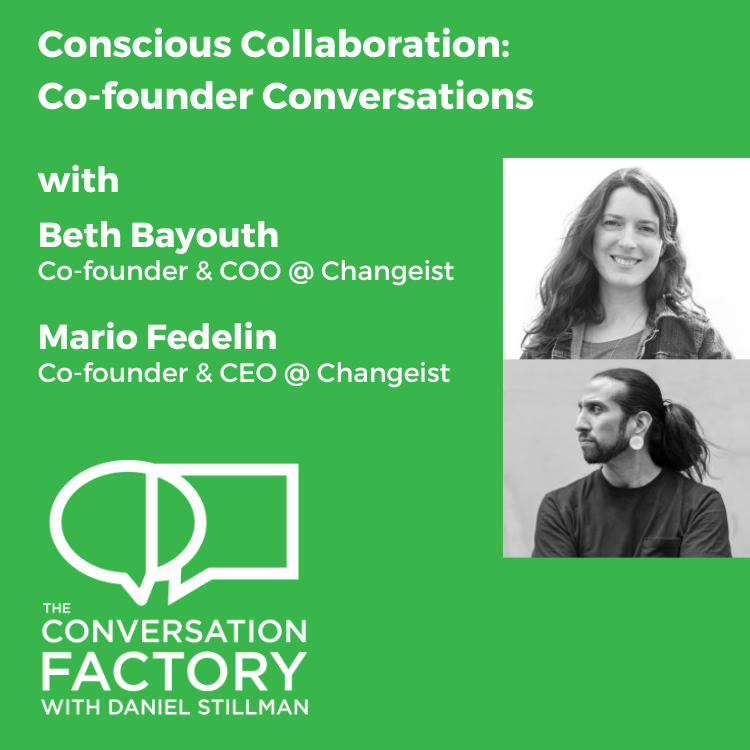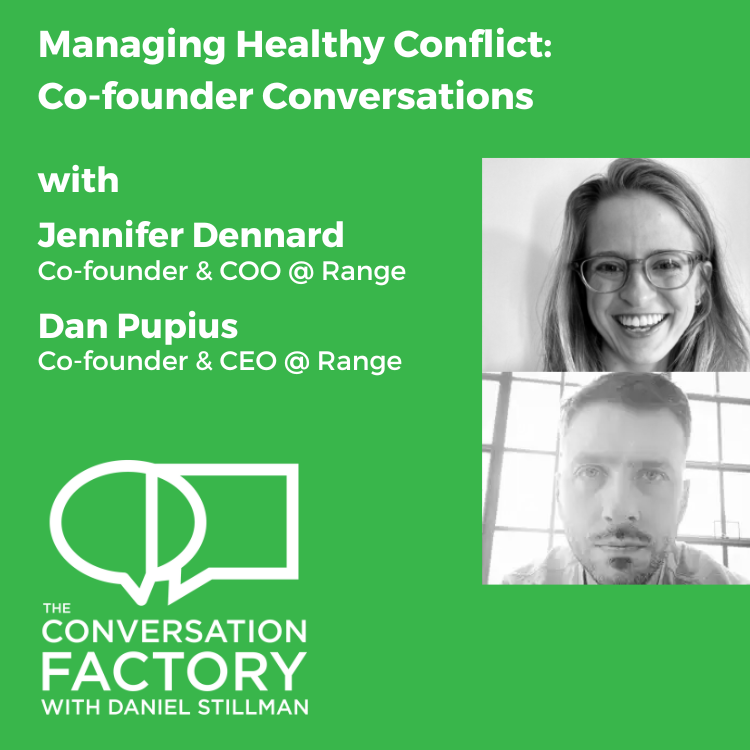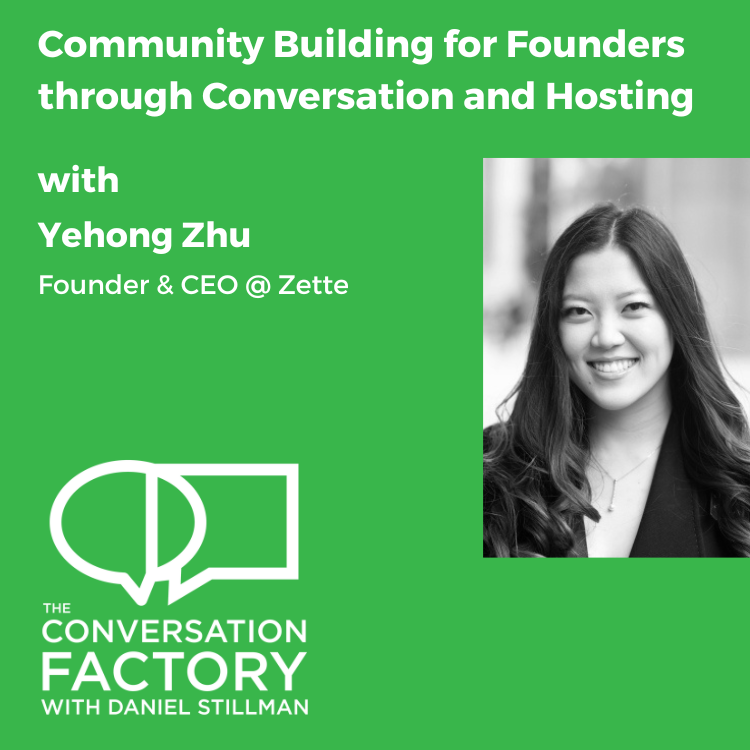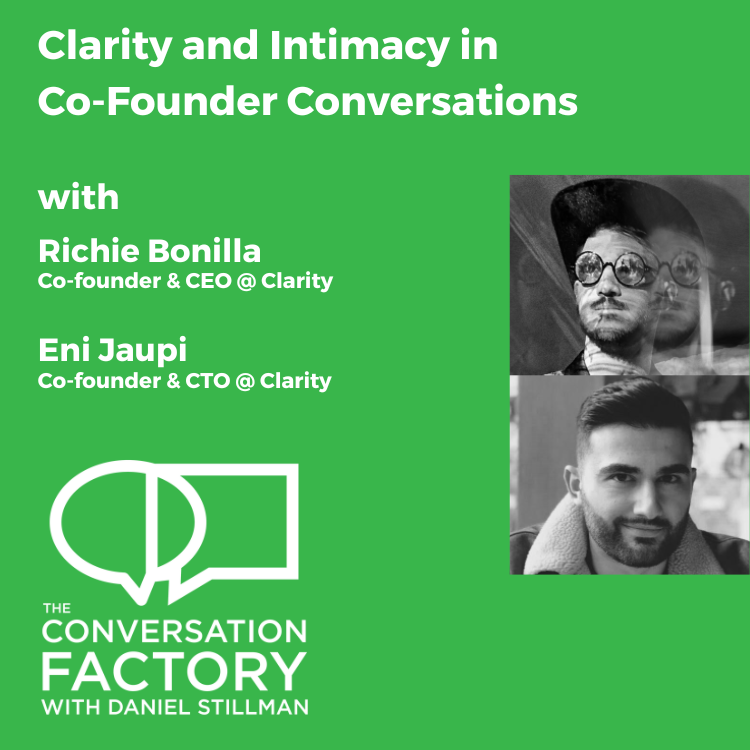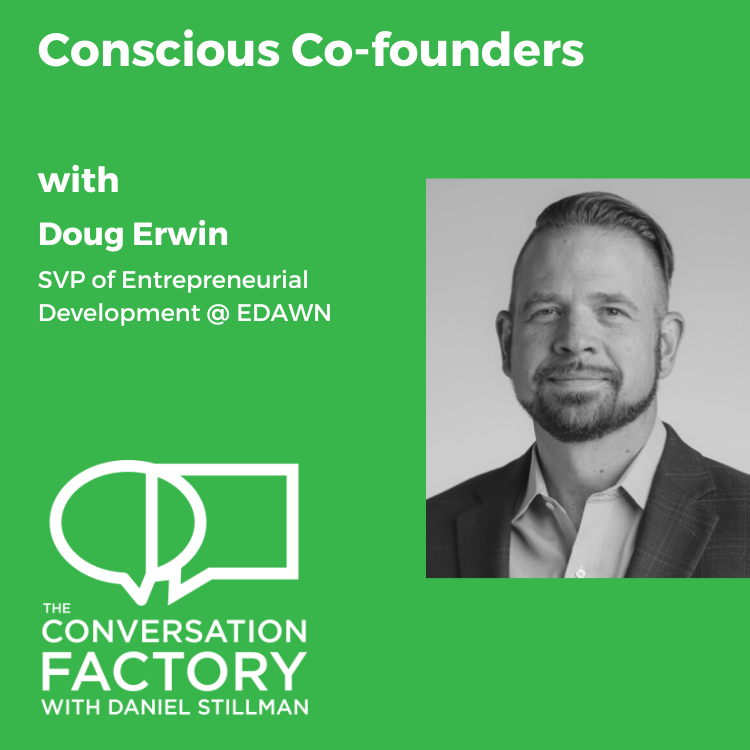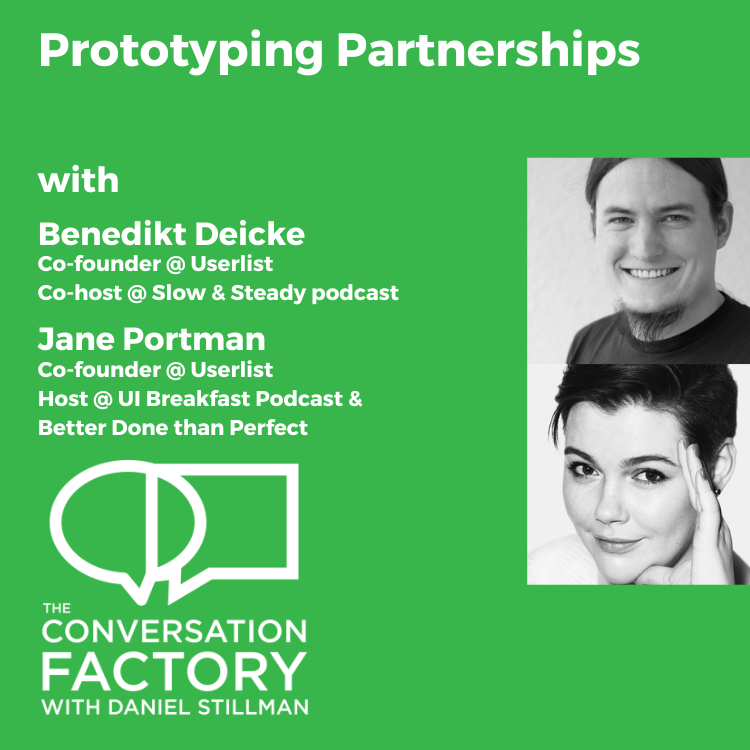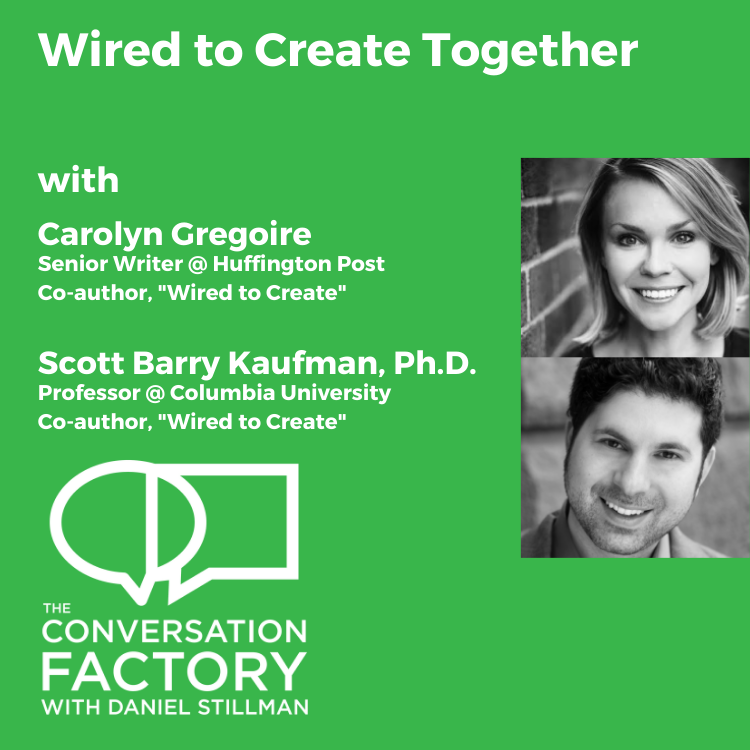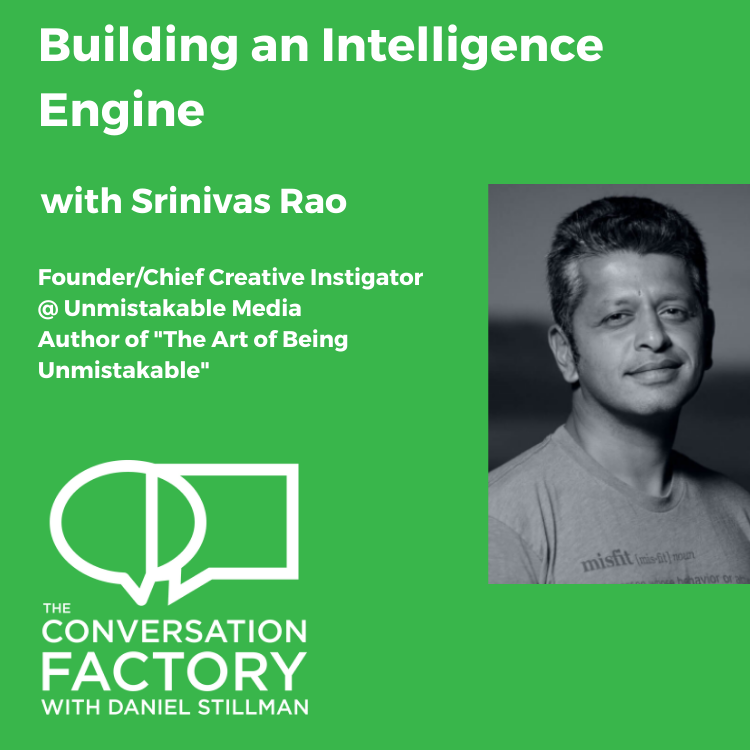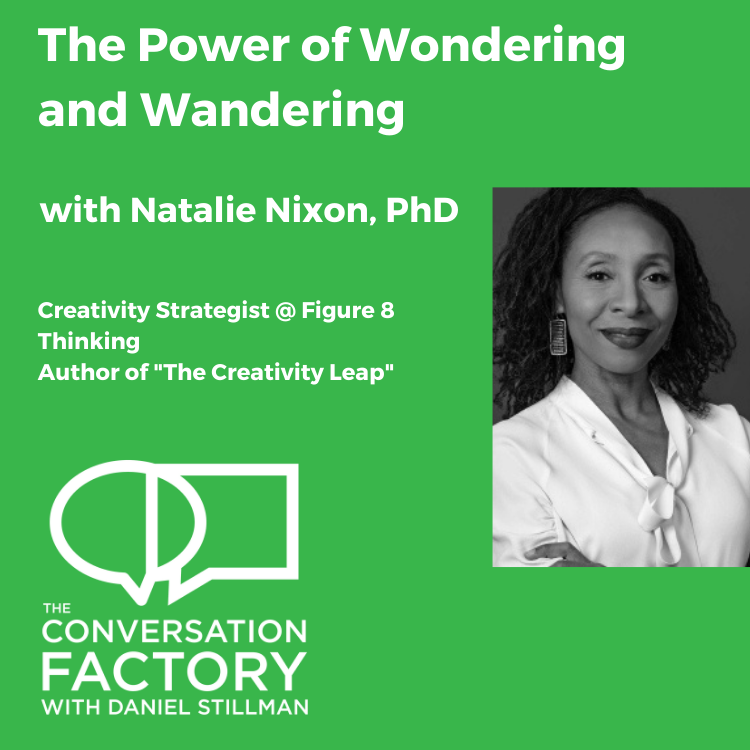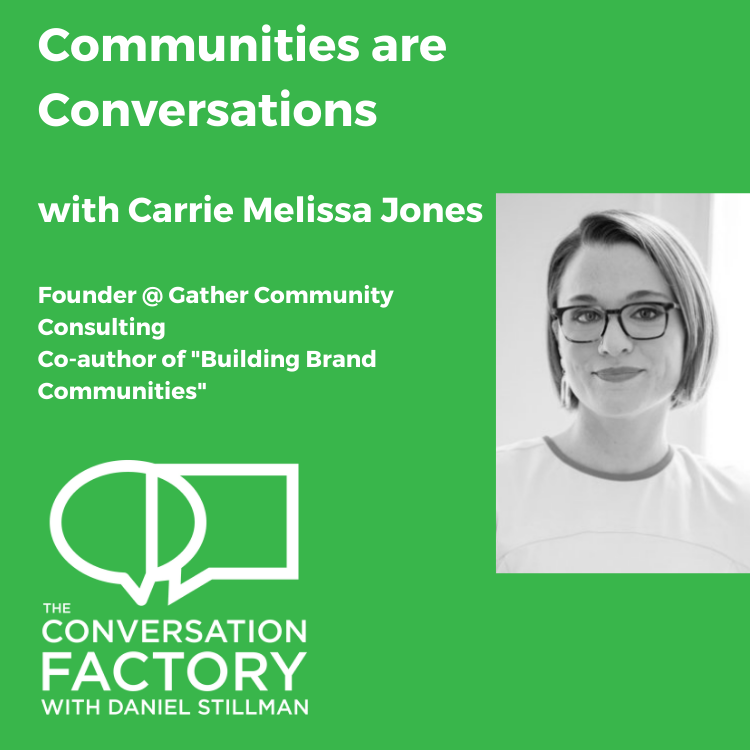In this conversation, I sat down with Beth Bayouth and Mario Fedelin, the COO and CEO (respectively) of Changeist, a non-profit organization dedicated to youth empowerment. They are building a community of young people that utilize their personal agency to create a more just society.
Changeist’s programs help 11-26 year olds learn a common civic language, engage in dialogue, and build community to investigate local and global social justice issues. Participants also work with other local community-based organizations to implement local solutions to local problems.
Together, Mario and Beth explore how they met, built a relationship and decided to work on this project together…and how they continue to manage themselves and each other in the entrepreneurship journey.
A few insights we’ll unpack about conscious co-founder relationships:
The key to a great co-founder relationship is that both of you do not fall apart at the same time!
Fighting Well and how Cofounder Intimacy can help: With cofounder intimacy, there is an understanding that often there’s something else behind a conflict or a mood. Because when you're close, you tend to know about what’s going on or that it’s safe to ask.
Knowing yourself and your skills
The Power of working with someone with a Different Skill Set but Similar Values
On Knowing yourself and your skills, and finding compliments on your core team:
A great leadership team requires Comfort with yourself and your skills and Respect for the skills of others... and it takes Balance - but Balance of what?!
On a leadership team you need:
+ Architects and Visionaries
+ Multipliers - someone who brings something you do not have to the table, who is also committed to the vision and the journey
Another way to think about this is that you need:
+ A Balance of Openers and Closers on the team.
This is the essence of conscious collaboration - knowing if you are more comfortable in a generative or divergent mode, ie, opening, or are more natural in the “Synthesizer” role - organizing, closing, or planning towards action. Mario owns his limitations as a “closer” and intentionally chose Beth as a COO for her natural “shark” skills - her ability to move things forward with clarity.
Mario and Beth also talked about their balanced styles in “Speeding up” and “Slowing Down” creative conversations - Beth will pump the brakes and ground ideas in reality when the time is right. Feeling that balance between creativity and clarity, speed and thoughtfully slowing things down, is the essence of conscious creativity and conscious collaboration…being comfortable with both opening and closing modes is critical, but collaborating with others who complement your natural approaches is powerful.
Be sure to check out my other co-founder conversations. I discussed building an Integrity Culture with the co-founders of Huddle, Michale Saloio and Stephanie Golik, and investigated prototyping partnerships with Jane Portman and Benedikt Deicke, co-founders of Userlist. (Which Mario and Beth absolutely did, as well!)
I also sat down with Jennifer Dennard and Dan Pupius, the co-founders of Range to unpack Healthy Conflict in Cofounder relationships. Conflict and collisions will inevitably happen in relationships, so you might as well learn to lean into it!
You may also enjoy my interview with Carolyn Gregoire and Scott Barry Kaufman, the co-authors of the 2015 bestseller, Wired to Create, where we unpack how they managed their working relationship and discuss Paired creativity, which is totally a thing!
And if you really want to dive deep into the idea of being a conscious co-founder, make sure to check out my conversation with my friend Doug Erwin, the Senior Vice President of Entrepreneurial Development at EDAWN, the Economic Development Authority of Western Nevada.
Links, Quotes, Notes, and Resources
On Healthy Conflict: https://theconversationfactory.com/podcast/managing-healthy-conflict-co-founder-conversations
Minute 19
Daniel Stillman:
And I'm wondering how, in those early days, the first week you decided to draw a boundary around this is what we're going to do, this is how we're going to work together. What was it like establishing your roles, your boundaries, your relationship in the early days? If you can remember back that far.
Beth Bayouth, COO:
I know, I am trying to remember back, it felt like it was more about... I think at that point we knew who we were as individuals and what our skills were. The boundary of who does what sort of naturally formed.
In the first month, I wrote our business plan obviously with the help of Mario who had already ideated a lot of... Understood who our competitors were, understood all of that. We applied for fiscal sponsorship through community partners. I think that stuff came easy and then it was just so much work. I don't know that we were super intentional about the relationship side of things right away because it was like, let's get the business plan, let's get fiscal sponsorship. As soon as we got fiscal sponsorship, we launched a crowdfunding campaign. That's just a lot of work. We wanted to show bigger institutional funders that we had this backing of individual supporters that really wanted this thing to happen. We raised in the first two months, then we raised 25,000 in a crowdfunding campaign just from friends and family and folks who had experienced the program that this had jumped off from.
Minute 21
Daniel Stillman:
I'm curious, what's your relationship like now? What is it? How do you work on your relationship these days?
Mario Fedelin, CEO:
I mean, I talk to her more than anyone. I talk to Beth more than any other person. If we rewind, there was this vulnerability, maybe there was... I'm going to say when we go back to that first conversation. I was very scared and I felt like I had put myself in a position to where I needed to find a way forward or else I was going to have to eat a lot of shit. I was going to have to go back on my word or I was going to have to tell people because I was just in a really tough place and I had no idea how to move forward. I think you're giving it too much time Beth that conversation, I feel like I asked you in the first 10 to 15 minutes, I was like, would you be interested? One, there was this built-in comfortability.
We've been friends prior. I have a lot of respect for Beth in the work that she had done and where she was at in her career. I knew that I was in safe hands and I trusted that and I had to be really vulnerable of saying, I don't know how to move forward and I really need help.
Minute 27
Daniel Stillman:
Tell me about that Mario. What does it mean to fight well for you?
Mario Fedelin, CEO:
I mean, we disagree on things. We'll get heated and we're both very... We have very strong opinions and...
Beth Bayouth, COO:
Passionate.
Mario Fedelin, CEO:
... We're very passionate about the things we're passionate about and so we'll fight. It's so funny too, sometimes it spills out into in front of our staff members or we'll just go back and forth and oftentimes it's one of us apologizing after we got done like, sorry, did I go too far? Look, we could figure this out. Or we apologize quickly. It's not hard to know when we're like... Also, we know each other's ticks so I know when Beth is really hurt personally or really upset about something and that trigger like I'll stop or we'll close it and then I'll be like, okay, I think I'll apologize. Then, we'll move past it pretty quickly. We're not afraid to confront that. We were arguing about something or we disagreed about something, let's sort it out. It's never personal. [inaudible 00:28:00].
Beth Bayouth, COO:
No, and it's interesting because we had mentioned all the personal side of things and I remember when I first entered the working world, you hear these things from your elders or whatever, don't share too much with your boss. Don't bring your personal life into work. It feels like that stuff isn't very effective. I think lots of times if one of us is overly affected by something that happens at work, it's largely there's something personal happening in our lives that I just can't handle this today. The fact that we're able to talk about all of that very honestly, it just makes for a better working relationship. We try to encourage our entire teams to... We try to make sure that people know that there aren't boundaries like that within our organization because I think we just know it's more effective for everybody to understand each other.
Minute 35
Beth Bayouth, COO:
I also though think to your other part of the question of what has happened to create that space for us, I think it's not just the personal side of things. I think we over the years have also just built trust, working trust in each other. I think we have both displayed that we are doing what we need to do for the other person to feel comfortable. I think along with Mario's vulnerability in the beginning of being able to say where he had shortcomings and moving this thing forward, he also had to really lay his trust in me that I was going to hold his vision dear and work as hard as he needed somebody to, to help make it happen. I know that that took some time.
I had to prove that I was there and I probably had to even take some time to really get there myself too. I think that just over the years we've been able to do that. That's why if I'm freaking out about something, I also know Mario's got it. It's time and time again, we've pulled through and it maybe was the last minute, but I think that we've built that working trust as well.
More about Beth and Mario
About Beth
In her role as Chief Operating Officer, Beth oversees the fundraising, operations, systems, and strategic planning for the organization. Prior to her work with Changeist, Beth received a MBA from Boston University with a focus on social impact. She then moved to Los Angeles to take on Local Control Funding Formula (LCFF) at Los Angeles Unified School District, helping to create new ways for teachers, staff, and stakeholders to better understand the complicated financial policies affecting LAUSD students and communities. Beth is committed to strengthening communities and empowering young people. She is a proud AmeriCorps alumna of City Year Chicago and in July 2017 was honored with City Year’s highest alumni recognition, the Comcast NBCUniversal Leadership Award.
About Mario
Mario spent over a decade in the national service movement with City Year. There developed and oversaw civic leadership programs for youth in three different markets. In 2014 he conceived of, designed, and launched Changeist.
Mario is currently a Board Member and Advisor to multiple community organizations in Los Angeles, a graduate of SCLN’s Leadership LA, recognized by the LA Empowerment Congress as a top 40 under 40 Civic Leader, and serves as a Senior Fellow for USC Marshal School of Business, Brittingham Social Enterprise Lab. In 2019, he was chosen out of thousands of applicants from over 160 countries to be an Obama Foundation Fellow. The Obama Fellowship supports outstanding civic innovators from around the world to amplify the impact of their work and inspire a wave of civic innovation.
Full Transcript
Daniel Stillman:
I am so grateful, Mario, Beth, that you are here to have this conversation about what it means to be a conscious partner in running a business together. I'm so excited you're here. Welcome aboard to the Conversation factory.
Beth Bayouth, COO:
Thanks for having us.
Mario Fedelin, CEO:
Thanks for having us.
Daniel Stillman:
Thank you very much. So Beth, I'm going to start with you. What's the origin story? How did you two come to work together in this big, crazy, topsy-turvy mixed up world? How did you two find each other and start working together?
Beth Bayouth, COO:
Sure. Mario and I met way back in 2005. We both started our careers as AmeriCorps members, happened to be working for the same organization but in different cities. I was in Chicago, he was in Philly. We both became staff members and were leading Saturday civic leadership development programs for middle school and high school youth. The organization brought us together. There was about a team of 10 of us nationwide who were all working on these programs and they wanted us to think through really what the overall learning outcomes were, how we could make sure that we were learning from each other and making each of those programs in the cities as best as they could be. We met then and that's sort of where our friendship and professional relationship started.
Daniel Stillman:
2005?
Mario Fedelin, CEO:
I also [inaudible 00:01:42] those times.
Beth Bayouth, COO:
You were young.
Mario Fedelin, CEO:
I was like this younger kid too who totally undereducated. I feel like I was a little bit in over my head in Philadelphia, how I landed there. At least that's how I felt. Beth, along with a couple other folks who had their degrees and they had been working on these programs, I was kind of trying to figure out how to navigate those dynamics of someone who's undereducated and someone who's educated and trying to do something together. It was an interesting start to the relationship.
Daniel Stillman:
So Mario, what brought you to AmeriCorps?
Mario Fedelin, CEO:
I found, again, it was a little bit of an accident. I guess the way that it starts is I grew up on the east side of San Jose. Had an opportunity for... And that's in the California suburb some people, it's called the South Bay. I had a teacher who, my brother had some challenges in high school, but everyone really liked him. As I came into that high school, people were like, oh, that's what's-his-name's little brother and so I think people kind of wrapped their arms around me a little bit. I got sent to a camp. Camp happened [inaudible 00:02:56] Santa Cruz Mountains and I had this really amazing camp counselor who was a brown kid that looked like me, but was very different than the other brown kids I ever met. Now, his name was John and we just had a blast for a week and that was a week in the Santa Cruz Mountains where we talked about, at that point they called the tolerance.
It was really diversity and racial justice and all those sorts of things. Anyways, fast forward, I graduated from high school, I had this adventure out, not going to college. When I came back to San Jose when I was 20 years old, I was transferring a expensive coffee shop chain. I was transferring from San Diego up into San Jose. Randomly as I was walking down, one of the alleyways [inaudible 00:03:42] San Antonio in downtown San Jose. I saw these random people walking that had these jackets on, these yellow jackets and it instantly, it was like, oh, my homeboy John used to work for that company. Maybe I could work with kids. That seems pretty cool because I didn't really have a plan. I walked into that recruiter's office and just so happens that they were hiring AmeriCorps members and at that moment, so it was a real quick start turnaround and I interviewed and I got placed on this diverse team working on civic leadership programs on Saturdays in my neighborhood. That's how it all kind of happened.
Daniel Stillman:
That's amazing. John's jacket was like...
Mario Fedelin, CEO:
The jacket, the symbol. It was a symbol.
Daniel Stillman:
That's amazing. The power of a symbol, the power of a properly chosen color.
Mario Fedelin, CEO:
It was less about... The color wasn't the indicator, it was a personal relationship that flagged it. I think that's the important thing to remember is we have our brands and our powerful brand narratives [inaudible 00:04:45] it would've never had the same meaning if John wasn't compassionate and the way that we exchanged ideas together and made me feel like I was a whole person in those moments. I mean, I had never spoken to him since and now it's been... We're looking at more than 27... 25 years later. I can still tell you his name. It's the person.
Daniel Stillman:
That's amazing. That connection. Beth, what brought you to AmeriCorps?
Mario Fedelin, CEO:
That's the power of youth workers.
Daniel Stillman:
Yeah.
Mario Fedelin, CEO:
That's the power of youth workers and the power of connection to people.
Daniel Stillman:
Yeah. Yeah. Sorry for cutting off there. But yeah Beth, I'm curious, what was your turning to AmeriCorps as well?
Beth Bayouth, COO:
Very different. I kind of had a very traditional path. I was supposed to go to college after high school. I did that in a pretty misguided way. I had no idea what I was doing there. What I wanted to do. Ended up majoring in business because it was practical. That was the only thing I could really think about getting out of the college experience other than I was a leader in clubs and the social aspect and living on my own and that kind of thing. When I graduated I didn't see myself doing anything business related. I didn't understand what I could really do with that degree that was going to appeal to my passions and what I had been doing thus far with volunteer work and everything. I had a friend who'd done an AmeriCorps program and was like, I think you'd really like this. I thought, well that sounds good. I've always worked with young people.
I was planning on moving to Chicago and it was a really good opportunity. It lined up with my timeline. I got in there and I was working in Chicago public schools and my whole family are public school teachers and I think I had been fighting whether that was supposed to be my reality. I was like, well this will be a good test run. I'm in the schools every day getting to see what it's like. Very quickly decided that that was... Definitely, I was right. That was not going to be my path, but I loved working with young people outside of school. I loved having that... The real relationships that you could build and thinking about how you supplement the school day and the academics with things that young people are really curious about.
Daniel Stillman:
That makes a lot of sense. I can really understand loving the content of education, but changing the context is really beautiful. 2005 to 2014, how did you get the band back together? What was the spark getting... I mean, because Changeist was 2014, but although I imagine it may have started a little bit earlier in your brain, Mario. Do you want to talk a little bit about the origin story of Changeist and then how you two wound up together and in the roles that you have in the company?
Mario Fedelin, CEO:
Yeah, so I was still working for that agency. That same organization, it's called City Year, but we had... I started in 2003, four we met in 2005. I became one of the guys who was working on the Saturday leadership programs for high school students. Beth and I worked even closer when we were working on the high school program because she actually had me come out to Chicago and work with her and a group of practitioners to thinking about starting a Chicago-based high school program. The organization had an opening in Los Angeles and so they brought me out in 2007 to launch their civic leadership programs down here and so that's how I landed in LA. It was really just as I was hitting the 10-year mark at that agency, I was tired.
I think I had a really tough year with just a little bit of burnout. I ended up having to close those civic leadership programs in 2011 because the organization wanted to focus, which ultimately was the right decision for that organization, but I had to help close down those nationwide and that all of our work that we had done together felt like it just got put on the shelf and benched when it was really the first program that agency had really put into standardization, which Beth and I were a part of. It felt like a little bit of waste, but I ended up retooling and just going straight into the education space with the organization and working on school campuses with principals. Then, I just wasn't that into it. I was organizing on school campus. That was the fun part where I was trying to raise money through school budgets and it wasn't exciting.
Looking at math scores and English scores for individuals just wasn't really what I had ever signed up for. Again, because I didn't go to college, I had these really big holes and gaps in knowledge and practice. Through those years when I was in LA I was volunteering for other agencies and boards and trying to develop my acumen. One of the organizations that I was working in was a program in South Central and mixed with this kind of itchiness to move on to something new and being with my partner watching this culminating event through one of the organizations that I volunteered for really part-time on the operational side, I just was like, you know what? I could do that. I could do that on my own and I could probably do it very differently and do something bigger. I just had that kind of itch.
It was that moment, at that culminating event on a college campus and then me and my partner went to go watch a movie and we got on one of the trains and I was seeing these kind of rec centers off the train that were beautifully kind of... Had art and graffiti on it. I was just like, I could do something bigger and different than what I'm doing now. Had some mimosas and I started Spouting off what I wanted to do because I had recently also had a bunch of young people come back. After those program closed, about three years ahead of that they started coming back in their senior years and saying, "Hey Mario, I'm running this thing for my school. Do you have any tips on how I could run this service project?" There was about three or four of them that came back that year also so now you have my own discount or my kind of burnout with these old students that were coming back for tooling up. And so they needed me for something and then me figuring out what the self-discovery looks like and seeing a gap in the youth workspace and my life partner when we're having a conversation, I was kind of throwing out this big picture idea of consulting for kids. I think it was the original version of it. She was like, "Yeah, you should do that." I was like, "I should do that."
Daniel Stillman:
That does sound like a mimosa. Talking a little bit.
Mario Fedelin, CEO:
Yeah, it was definitely mimosa. Got all very excited about it.
Daniel Stillman:
But supportive, which is really good.
Mario Fedelin, CEO:
Yeah, right. Then she told me, she was like, and we can live with my mom if you want, we could figure this out together. I was like yeah, we should do that. Then, on Monday it still sounded like a good idea. That Monday I told my boss at that point and I was like, I'm going to leave here. I'm going to give you some time. I can't leave now, but this is going to be my last round and I want to start a non-profit. To their credit, that agency City Year and the people there were just like, hell yeah, we'll help you do it however we can help.
Then, I started down the journey of figuring out, well what kind of team can I put together? And I got all of my favorite people that I'd worked with in the past in LA together and started taking one day a week off at City Year to think about big picture stuff and think about what this program would be. And I started these meetings with folks and just started to build. And Beth wasn't part of that yet, but that was the early days of 2013 I'm assuming that I started putting the stuff together.
Daniel Stillman:
That's amazing. And so Beth, what was your experience like coming into Changeist? What did things look like when you stepped in?
Beth Bayouth, COO:
Yeah, so after leaving City Year as a staff member, I took a couple years and then I went back to school and ended up getting a master's in business so business was the right choice, happenstance. That experience brought me out to... That was in Boston and I ended up doing a fellowship that brought me out to LA for a summer. Working with LA Unified and... First, it started my love for Los Angeles and I was really excited to try and come back once I finished my master's and I was able to. In summer of 2011 I moved out to LA permanently and was continuing the project that I got that fellowship with. I was working with Los Angeles Unified School District on what's now their local control funding formula and was working in the district office. I did that for a couple of years and just felt a bit disconnected.
I was really missing the vibrancy of that feeling that you would get with organizations like City Year and working on something. I definitely am a behind the scenes type of worker, but also I like being able to be close to the young people that we engage with. I was looking for something new. Mario got sort of stuck where he was at, I would say, is that fair?
Mario Fedelin, CEO:
Very Fair.
Beth Bayouth, COO:
And a lot of folks... We had people in common, we had friends in common and it got into Mario's ear that I was looking for something new. He was like, can we go get some coffee? I think it was like 45 minutes into reconnecting and he was like, you want to help me start this small nonprofit? And I was like, yeah, let's do this, let's do this again. I took a few weeks and talked to my husband about it and thankfully he's in tech startups, so was kind of like, yeah, this is your turn to do a startup. Let's see how it goes. Talked to a couple of our mutual friends and was just like, yeah, Mario's been working on this. I've been working on it with him. This is legit.
Mario Fedelin, CEO:
I mean, also she really was more like, "Sure, that sounds cool." I don't know if it was as optimistic conversation because that was like, "Oh shit, is she really going to do this?" And then she goes back to all of our friends. I also hear, and so she's talking to everyone to make sure I wasn't full of crap and make sure that we actually had some foundation of thought put into it. Then she committed and she's like, I'll do it. I'm in until October. It's like, I could do this until October. This was a meeting in what? Was it in April? We had this conversation?
Beth Bayouth, COO:
Yeah, March or April.
Mario Fedelin, CEO:
Maybe March.
Beth Bayouth, COO:
I think I said, I'll give you six months and see if we can raise some money.
Mario Fedelin, CEO:
I was like, all right. Technically, Beth was the first person to work on Changeist full-time.
Daniel Stillman:
Wow.
Mario Fedelin, CEO:
Free. I mean, also what we got... Where we had gotten was we had worked with this group. I had called them our architects and they had really helped put shape to this thing. At the point when I was in probably February, I thought that we had some pretty cool stuff lined up. This seems like we could do this. I could actually right now go get some young people, we could launch this. But my job was ending at City Year. I had no personal money, I was crap at saving money personally. We weren't able to get that together and I had no way to raise money because we had no 501 C3 and no financial back, no kind of infrastructure. That was the stump point. This is where we like to say that... People were in my ear about Beth being on a job hunt, but also her LinkedIn spammed me. I was like, oh Beth. I got this random email from LinkedIn and I was like, oh yeah. I was like, of course. It's a sign because someone just said Beth's name and now her LinkedIn is... Said add me to your network. That's kind of how we reconnected.
Daniel Stillman:
This is the moment inside the moment and I want to zoom in because this is the first conversation. There's coffee and there's an agreement to a limited experiment to see where things could go. And I'm wondering how, in those early days, the first week you decided to draw a boundary around this is what we're going to do, this is how we're going to work together. What was it like establishing your roles, your boundaries, your relationship in the early days? If you can remember back that far.
Beth Bayouth, COO:
I know, I am trying to remember back, it felt like it was more about... I think at that point we knew who we were as individuals and what our skills were. The boundary of who does what sort of naturally formed.
In the first month, I wrote our business plan obviously with the help of Mario who had already ideated a lot of... Understood who our competitors were, understood all of that. We applied for fiscal sponsorship through community partners. I think that stuff came easy and then it was just so much work. I don't know that we were super intentional about the relationship side of things right away because it was like, let's get the business plan, let's get fiscal sponsorship. As soon as we got fiscal sponsorship, we launched a crowdfunding campaign. That's just a lot of work. We wanted to show bigger institutional funders that we had this backing of individual supporters that really wanted this thing to happen. We raised in the first two months, then we raised 25,000 in a crowdfunding campaign just from friends and family and folks who had experienced the program that this had jumped off from.
Daniel Stillman:
I'm curious, what's your relationship like now? What is it? How do you work on your relationship these days?
Mario Fedelin, CEO:
I mean, I talk to her more than anyone. I talk to Beth more than any other person. If we rewind, there was this vulnerability, maybe there was... I'm going to say when we go back to that first conversation. I was very scared and I felt like I had put myself in a position to where I needed to find a way forward or else I was going to have to eat a lot of shit. I was going to have to go back on my word or I was going to have to tell people because I was just in a really tough place and I had no idea how to move forward. I think you're giving it too much time Beth that conversation, I feel like I asked you in the first 10 to 15 minutes, I was like, would you be interested? One, there was this built in comfortability.
We've been friends prior. I have a lot of respect for Beth in the work that she had done and where she was at in her career. I knew that I was in safe hand and I trusted that and I had to be really vulnerable of saying, I don't know how to move forward and I really need help. I think when Beth says that we knew who we were, it was like I knew what I was really good at and I knew that Beth was in a much different place and there was overlap in some of that stuff. In a lot of ways I didn't hire some... I didn't hire or we didn't sign onto something where we were both going to be having the same type of skill sets. It was like Beth is... Beth is a little shark and I needed someone to help push the ideas forward because I was the one who was throwing everything out on the wall and Beth was able to ground it and plant it. That is still the case in our relationships is I'm the one that comes with the ridiculous idea and Beth's like, that's dumb. And I'm like, you're right. That is dumb.
Or I give the idea and she's like, yeah, that's a good one. Then [inaudible 00:23:11] gives it life and brings it to life. We talk all the time. I mean, we've been through a lot together in the last nine years. It's like family deaths, a pandemic, to emotional [inaudible 00:23:27] relationships, childbirths. We have two kids that were born including one that was the very first four months. Let me tell you this story. I think we're in office [inaudible 00:23:38] in the first three months of this happening. I think we just got our money, maybe. So we're going to a presentation or something [inaudible 00:23:47] and she was like, I have something to tell you. I'm pregnant. I'm like, okay. And I'm like, oh man, is she going to walk away? Then, it was fine because we were like, yes, we're building this to be a family thing, so of course we'll figure this all out.
Then, the real pain came in is when six months hit. It was October, November and we still had no other money except for that 25,000. I'm like, how did I walk this friend into a shit storm who is about to have a baby and we have no financial security and this is going to fall apart. I was really scared. I remember sitting on my bed crying to my... Actually, physically sitting there crying on the bed after having a conversation with Beth where Beth was not upset about anything at all, but I was just so scared that I wouldn't be able to get us on payroll. She wouldn't be able to have things she needs to support her family as she gets started on that journey. There was no prospects, but Beth was steady. She was like, it's fine, we're going to get through this. Then, a month later we had $200,000 show up and a bunch of things that we had talked about with friends out and then just all just showed up and came together.
Daniel Stillman:
I'm sitting here and I'm pulling these threads together in my mind from an appreciative inquiry lens. What I'm hearing that is alive and powerfully functional in the way you two relate. One is just a human foundation, having known each other, having worked together there is the ability to be vulnerable with each other, which doesn't come... Is nontrivial. That doesn't come for free. That's something that's earned. The other thing that I'm hearing, the fourth thing is that you both have a sense of who you are, you know what you are good at, and you also know and respect what the other person is good at. There's that space to have the other person step in and the two things that I'm hearing, this is something in the design world, we talk about opening and closing or divergent and convergent. Sometimes people are divergers and convergers. Mario, you're a really good diverger, and Beth, you're a really great converger. The fact that you have, if both of you were divergers, it would be really, really hard. You need a closer, everybody needs a closer. Then, underneath all of that seems to be a very strong undercurrent of respect, which is all really powerful. Is there anything else that you feel like is alive in your relationship that I missed or that we haven't talked about yet?
Mario Fedelin, CEO:
We fight really well.
Daniel Stillman:
Tell me about that Mario. What does it mean to fight well for you?
Mario Fedelin, CEO:
I mean, we disagree on things. We'll get heated and we're both very... We have very strong opinions and...
Beth Bayouth, COO:
Passionate.
Mario Fedelin, CEO:
... We're very passionate about the things we're passionate about and so we'll fight. It's so funny too, sometimes it spills out into in front of our staff members or we'll just go back and forth and oftentimes it's one of us apologizing after we got done like, sorry, did I go too far? Look, we could figure this out. Or we apologize quickly. It's not hard to know when we're like... Also, we know each other's ticks so I know when Beth is really hurt personally or really upset about something and that trigger like I'll stop or we'll close it and then I'll be like, okay, I think I'll apologize. Then, we'll move past it pretty quickly. We're not afraid to confront that. We were arguing about something or we disagreed about something, let's sort it out. It's never personal. [inaudible 00:28:00].
Beth Bayouth, COO:
No, and it's interesting because we had mentioned all the personal side of things and I remember when I first entered the working world, you hear these things from your elders or whatever, don't share too much with your boss. Don't bring your personal life into work. It feels like that stuff isn't very effective. I think lots of times if one of us is overly affected by something that happens at work, it's largely there's something personal happening in our lives that I just can't handle this today. The fact that we're able to talk about all of that very honestly, it just makes for a better working relationship. We try to encourage our entire teams to... We try to make sure that people know that there aren't boundaries like that within our organization because I think we just know it's more effective for everybody to understand each other.
Daniel Stillman:
That's really interesting. In a way, so there's two things I'm hearing. Mario fighting well means recognizing when you've crossed a line, knowing how you're affecting the other person, apologizing quickly if need be. I think there's another piece of this, Beth, which is knowing that if you are getting under each other's skin, it's because there might be... There's often something else outside of the work sphere that is affecting things. Because you're close, you tend to know about that or that you can ask about that. We're not going to be watching this so they're both nodding right now in sync even though they're in two different places, which is amazing.
Beth Bayouth, COO:
Yeah. I can recognize, oh I am feeling really strongly about this, but you know what, it's because my daughter's sick or it's been stressful at home or something and I can take a step back and be like, Mario, let's... Can we just table this conversation? And it's welcomed. It's understood.
Daniel Stillman:
Yeah.
Mario Fedelin, CEO:
I also point out too, I think it's... We've rarely both been in a place of instability at the same time or we both handle things... Whenever I'm like, we're not going to finish in the black and I'm freaking out over something, there's always this sense of calm. Whether it's intentional, or unintentional from Beth to be like, look, there's an out here. And vice versa. Beth is on the verge of freaking out about something that's happening. I'm like, I'm not that worried about it. Look, we're going to be fine. We've been in lock sync. I think that's been kind of one of the things where it's been... Whenever it all feels like it's falling apart, Beth never believes it is. That has helped us get through this. That's really hard to find, I think in a collaborator.
Beth Bayouth, COO:
Yeah, we're definitely able to balance each other.
Daniel Stillman:
I've heard...
Mario Fedelin, CEO:
How many times has this organization fall... How many times has this organization felt like it was about to fall apart completely? And one of us is just like, look, we'll get through this.
Daniel Stillman:
So the key is both of you not fall apart at the same time and somehow it just doesn't happen?
Beth Bayouth, COO:
It has not happened yet.
Mario Fedelin, CEO:
And we've gone through a global pandemic, so who knows what the threshold's going to be. If it wasn't for Beth, this would never have happened. There's no way.
Beth Bayouth, COO:
I mean, you had the idea.
Mario Fedelin, CEO:
Yeah, but it was nothing without having some grounding and some [inaudible 00:32:17] and that came through what you brought to the table. And I don't know that... I don't know that I would've had a different collaborator. I don't know that a different collaborator would've helped me weather all this stuff.
Daniel Stillman:
Beth, good job on taking a compliment. I know for myself it's a skill that I under-utilize. I'm much better at batting them away.
Beth Bayouth, COO:
Yeah, it's hard, but I'm working on it.
Daniel Stillman:
It's a thing. Well, speaking of working on things, what do you feel are some of the challenging parts of your relationship that you've had to work through? What comes to your mind when you say Hmm Beth?
Beth Bayouth, COO:
It doesn't ever feel challenging.
Daniel Stillman:
Yeah.
Beth Bayouth, COO:
I'm sure there are. I'm sure I'm just missing something here, but nothing ever feels like we can't talk about or we really overstepped.
Daniel Stillman:
Yeah. What do you feel... So there's this phrase that I've heard some folks use, which is that everything is workable. There's this container here in your relationship where things can be discussed. I guess what I'm curious about is what has enabled you two to create a space where you feel safe to work through what you need to work through?
Mario Fedelin, CEO:
History. I don't know, context.
Daniel Stillman:
History and Context.
Mario Fedelin, CEO:
Friendship.
Our partners know each other. Our kids play together. How I live down the street from her for a year in that same complex. I think maybe if I'm picking at what's hard, at least... There hasn't been a problem yet, but I do wonder what does our future look like, and how long can we do this for? And what happens when one of us is ready to walk away? Being able to allow the other person grace to do that. I think that's something I'm thinking about in terms of our relationship is like, it's going to be tough because life is changing, it's almost going to be a decade. We got to be able to allow ourselves to grow. Although, I keep trying to pull Beth into other collaborations. I want to start another business with her. I'm like, how about we do this? How about we do that?
Daniel Stillman:
That's interesting.
Beth Bayouth, COO:
Again, I slow it down.
Mario Fedelin, CEO:
That's something to think about. How does it end? Beth is not my life partner, so we're not married. That means that this is... At one point, this relationship is going to come to an end because I can't imagine us running Changeist forever together. That has to be a concern or a thoughtful because we have so much mutual respect for one another and a deep friendship. I can imagine how it would be much harder to say goodbye or to say I got to go. I mean we, I don't know. Beth's probably like, "Nah, it's cool." She'll tell me. When do we say now it's time and not have resentment for the other person walking away?
Beth Bayouth, COO:
Yeah, I agree with that. I also though think to your other part of the question of what has happened to create that space for us, I think it's not just the personal side of things. I think we over the years have also just built trust, working trust in each other. I think we have both displayed that we are doing what we need to do for the other person to feel comfortable. I think along with Mario's vulnerability in the beginning of being able to say where he had shortcomings and moving this thing forward, he also had to really lay his trust in me that I was going to hold his vision dear and work as hard as he needed somebody to, to help make it happen. I know that that took some time.
I had to prove that I was there and I probably had to even take some time to really get there myself too. I think that just over the years we've been able to do that. That's why if I'm freaking out about something, I also know Mario's got it. It's time and time again, we've pulled through and it maybe was the last minute, but I think that we've built that working trust as well.
Daniel Stillman:
If you were talking to young entrepreneurs at the beginning of their journey now, what kind of advice would you be offering them to build the kind of relationship, the kind of longevity that you two have had?
Mario Fedelin, CEO:
I think with entrepreneurs, at least the stuff I've heard or read is always [inaudible 00:37:59] the only ship that sinks the partnership. I don't know if you've heard that, is don't do things together with another person.
Daniel Stillman:
I have never heard that.
Mario Fedelin, CEO:
I don't know if maybe I'm being the wrong things... There is a school of thought that's like, you go alone and then bring people in. I would take the advice of someone... The founder that City Year told me it was just find a partner. Someone that could vouch for you and someone you trust and someone that will always say that you're doing well to another person when they ask about you. So that you could weather some of the tough storms through the entrepreneurial journey. Because it's tough. Again, all the hard stuff is always about personal fear. I feel like all the things that we've ever had... Weather that have been seemingly dire or real consequential were personal ego or self insecurity and of being at the table or knowing what to say. Everything else is learnable and manageable. Being able to have another person help you, whether that stuff personally, I think that's made this thing float. Finding that other person, and it can't just be anyone, it's got to be someone that has a different skill set, similar values that's willing to go through it with you.
Beth Bayouth, COO:
And you have to be able to admit that you have to have enough trust in them that you can admit when you don't know what you're doing or you're wrong or you're scared because otherwise it's not a relationship worth having.
Daniel Stillman:
Well and it's also to what you were just saying, Mario, if these things are learnable, if we aren't willing to say that we don't know them, it's hard to learn them.
Mario Fedelin, CEO:
Yeah, [inaudible 00:40:01].
Daniel Stillman:
Uh oh, did I freeze or did Mario freeze?
Beth Bayouth, COO:
Mario froze.
Mario Fedelin, CEO:
Oh no, I froze.
Daniel Stillman:
Oh, you're back.
Mario Fedelin, CEO:
Oh no, I froze.
Daniel Stillman:
Just say whatever... Just say whatever you said exactly the same way.
Mario Fedelin, CEO:
I was just saying the myth... I think the myth around the entrepreneur side of stuff is like, it's not the technical stuff that's hard. That's the easy part. You could always figure out the technical stuff. There's always someone you could bring in. There's always someone to talk to, to help you through this thing, this finance report or raising money or building this. That stuff is easy. You find anyone could do that. The hard part I think is having the strength to endure and that's where a friend comes in.
Daniel Stillman:
So we're amazingly getting very close to the end of our time. Beth, what haven't I asked you about having a powerful relationship as two folks running the core of a business? What haven't we talked about that we should have talked about?
Beth Bayouth, COO:
Sometimes, I wonder how does our partnership come across to the rest of our team?
Do they think we have each other's backs, even if we're totally wrong? That kind of thing. I'm curious, and I don't think we've ever really talked to anybody on our team about it, but I wonder how it affects everybody as a whole. We've never explored it. I don't know how... We'd probably have to do some sort of external consulting to find out, but I would like to think that it's helpful. I would like to think we're modeling how we want everybody to operate or how they support their own teammates, but we don't know.
Daniel Stillman:
That's a really interesting question. And hearing the two of you talk about the quality of fighting well and I was like, oh, I wonder if that trickles down. I'm curious about that too. And that would be really interesting to learn about for sure.
Mario Fedelin, CEO:
Especially, because we're the bosses, so you're the boss in those spaces. Then, when we both start going at it, I imagine people are like, oh, this is awkward.
Beth Bayouth, COO:
I mean, let's be fair, we're not fighting, we're just disagreeing.
Daniel Stillman:
Yeah, yeah.
Beth Bayouth, COO:
But we're both very blunt. When we're delivering a disagreement to each other, we know we don't have to sugarcoat it. If other people are present, maybe that feels uncomfortable. I've never received that feedback, but I can imagine that that could be.
Mario Fedelin, CEO:
I could imagine.
Daniel Stillman:
Well, for the two of you, with the folks that you manage, do you feel like you conduct yourself in a similar way that the quality of your conversations are similar?
Beth Bayouth, COO:
I think we both are very clear that we are open for feedback and discussion and really want to understand how people are feeling, but there's still the dynamic of supervisor and employee, especially with folks who might be newly entering a career and really figuring out what can they really do and say, I think, you see different levels of what that looks like with other relationships.
Daniel Stillman:
Yeah. And it seems like the two of you really relate to each other as equals, which is really powerful.
Mario Fedelin, CEO:
Yeah.
Daniel Stillman:
Well, I really appreciate you two taking the time to be so reflective and vulnerable and real. These are such wonderful qualities to notice in a high quality partnership. I'm glad that you two have been able to create that for each other and especially in service of the mission that you two are serving. That's awesome.
Mario Fedelin, CEO:
I couldn't ask for a better partner.
Beth Bayouth, COO:
Same.
Daniel Stillman:
Well, that seems like a great place to call scene.
